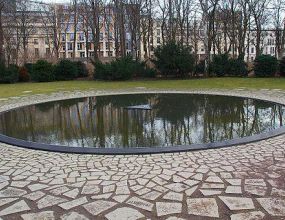 Source: Wikimedia Commons.
Source: Wikimedia Commons. The Roma and Sinti Monument in Berlin stands as a solemn reminder of the persecution and suffering endured by the Roma people during the Holocaust. Located in the Tiergarten district of the city, the monument was unveiled in October 2012 to commemorate the Sinti and Roma who were killed by National Socialist during World War II. The Roma and Sinti Monument in Berlin serves as a powerful symbol of remembrance and reflection, urging visitors to never forget the horrors of the past.
Designed by Israeli artist Dani Karavan the memorial consists of a circular pool with a triangular stone stele at its center, referring to the fact that all those imprisoned by the Nazis were identified with differently coloured triangles on their prisoner clothing. A single fresh flower is placed on the stone daily, as a symbol of the ongoing remembrance of those murdered. The surrounding area is inscribed with the "Auschwitz" by Italian Roma Santino Spinello, where it is written around the edge of the water basin, in English, German, and Romani: "Sunken in face / extinguished eyes / cold lips / silence / a torn heart / without breath / without words / no tears".
Trees around the monument give a tranquillity and private place for every visitor. It is crucial for people to have places like this when there isn’t even a grave to put flowers to commemorate the perished ones, and this monument is the only place where they can do this. For many, the memorial is a poignant symbol of their historical and continuing fight for recognition and equality.
Educational programs and guided tours aim to raise awareness about the Porajmos (Roma Genocide), evoking a deeper understanding and empathy among visitors. However, a lot more needs to be done to integrate Roma history into the broader Genocide narrative and educational curricula. Despite the horrific numbers, the Roma genocide did not receive immediate recognition post-war, and it took decades for their suffering to be officially acknowledged. The Federal Republic of Germany recognized the Sinti and Roma Genocide only in 1982, and it took thirty more years of political struggle before the memorial could be inaugurated in 2012 – 67 years after the end of the Second World War. But this symbolic acknowledging of Federal Republic of Germany of its responsibility for the crimes committed against the Sinti and Roma means a lot for history, it’s an act against forgetting. The suffering that Roma had to endure during Hitler's National Socialism should become part of the “historical memory” of Germany, said Romani Rose, chairman of the Central Council of Roma in Germany, in an interview with Bayerischer Rundfunk.
The Roma and Sinti Monument in Berlin serves as a powerful symbol of remembrance and reflection, urging visitors to never forget the horrors of the past. It stands as a testament to the resilience and strength of the Roma people, who continue to face discrimination and persecution to this day. We can honor their memory by standing up against hatred and intolerance, and by building a world where such atrocities can never happen again.